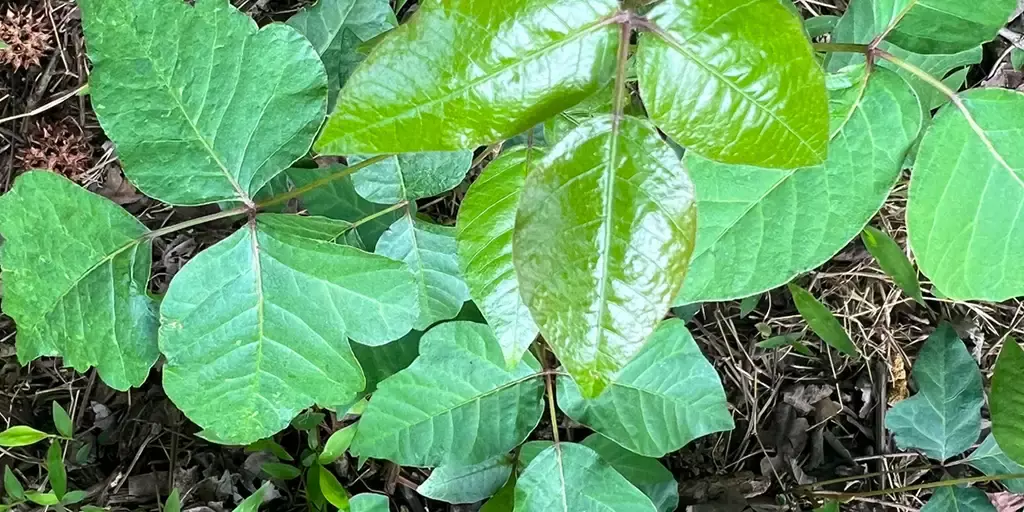When enjoying the great outdoors, coming into contact with certain plants can turn an idyllic summer day into an itchy nightmare. The main plants that have gained notoriety for their itch-inducing rashes are: poison ivy, poison oak, and poison sumac – but what’s the difference between them? It’s important to learn how to identify each species, how to get their oil off of your skin if you touch them, and what to do if you break out in a rash from one of these plants. We’ll cover what you need to know to help you avoid or ease an uncomfortable encounter with some of nature’s most noxious leaves.
What Makes These Plants Dangerous?
Poison ivy, poison oak, and poison sumac aren’t actually poisonous themselves, but they all contain the same offending compound called urushiol oil that can cause an allergic reaction in the majority of individuals. Urushiol oil is so potent that it only takes an incredibly small amount to cause a reaction. This odorless, colorless oil binds to surfaces extremely well, and can live on for years – even after the plant has died or has been removed. It can also cling to pet fur, clothing, or other surfaces that it comes into contact with.
Individuals can become allergic to urushiol at any point in their lives, and in varying degrees of severity. In fact, it’s estimated that 85% of the population is allergic to urushiol oil, leaving only 15% of individuals unaffected. If you’re allergic to poison ivy, oak, or sumac, you’re likely to experience:
- An intensely itchy, red rash
- Small bumps or blisters
- Localized swelling
These reactions are typically seen in a pattern consistent with exposure. The areas of skin that received the most exposure will break out first, usually in a linear pattern from brushing against the plant. This initial reaction can occur anywhere from hours to days after exposure to urushiol oil.
Other areas of the skin may break out in the following days in a seemingly random pattern. This is due to the spread of the oil while it was on your hands from the initial encounter – not the rash itself spreading. Poison ivy, oak, or sumac rashes may appear to “spread” for several days after the initial rash appears, and will itch for 1-2 weeks. Blisters will form, burst, and eventually crust over, which usually marks the end of the intensely itchy period. Poison ivy, oak, and sumac rashes are not contagious to others.
Those with a sensitivity to urushiol oil should also exercise caution when burning brush, timber, or kindling in areas where these plants abound. When burned and inhaled, urushiol can cause severe respiratory reactions. This is especially important for people making campfires, where they will be in close proximity or cooking meals over the smoke.
Recognizing Plants Containing Urushiol
In the United States, you’re likely to encounter at least one of the three main culprits that carry urushiol oil. These plants are prevalent in nearly every state in the US, and they thrive in areas that people frequent. Knowing how to identify these plants will help spare you from itchy rashes after camping trips, yardwork, hikes, or even a stroll through your neighborhood.
Poison Ivy
Poison ivy is perhaps the most well known of the rash-causing plants. It grows as a vine, shrub, or straight up out of the ground in individual sprigs depending on the species. Poison ivy is found across most of North America, and thrives in many environments. Wooded areas, alongside roads and paths, and open fields are some favorable locations for poison ivy.
The key identifying feature of this plant is to look for “leaves of three.” In fact, you’ve likely heard the saying “leaves of three, let it be” in reference to poison ivy. This helpful reminder can spare you the discomfort of coming into contact with the itchy offender. In addition to the tri-leaf pattern, each cluster of three leaves consists of pointed leaflets, which can be smooth or toothed. The surface of the leaves can appear shiny or dull, and can vary in size and shape. Poison ivy often produces green, white, or yellow berries or flowers in the spring and summer, and its leaves will turn red during the fall.
Poison Oak
Western poison oak is found along the Pacific coast, while eastern poison oak is native to the southeastern states. Its habitat is in forests, grasslands, and sometimes in dry or sandy soil. Its appearance can vary depending on the species.
Similar to poison ivy, poison oak usually has clusters of three leaves, but some species can have 5,7, or 9 leaves per cluster. Poison oak tends to grow as a shrub rather than a vine, though individual plants can be found as well. As its name suggests, poison oak leaves resemble oak leaves, and are scalloped or lobed in shape. The leaves often appear fuzzy due to fine hairs along each leaf. Poison oak can also produce white or yellow berries, and its leaves will change to red or brown in the fall.
Poison Sumac
This plant looks quite different from its urushiol-carrying cousins, but still carries the same offending oil. Poison sumac grows as a tall shrub or small tree, and is typically found in wet areas. It can be found in northeast and some midwest states, and in the swamps of the southeast.
Poison sumac leaves are pinnate, meaning they are arranged in a symmetrical row of pairs along the central stem, and usually with 7 to 13 leaflets per leaf. The leaflets are elongated with smooth edges, and a glossy surface. Poison sumac can produce white or yellow berries or flowers, and the leaves will change along with the seasons. Some leaves may have small splotches resembling black paint.
How to Prevent Poison Ivy, Poison Oak, and Poison Sumac Rashes
Avoidance is the best prevention when it comes to these plants. Know how to identify each species, and wear long clothing to prevent accidental encounters. Pants, long sleeves, boots, and gloves can protect your skin from urushiol oil.
If your skin does come into contact with poison ivy, oak, or sumac, it’s important to remove the oil as quickly as possible. You won’t be able to see or feel the oil, so being aware of your surroundings is key when assessing whether or not you’ve come into contact with urushiol.
Removing the Oil
Rinse exposed skin with lukewarm, soapy water, ideally within the first 30 minutes after exposure to the plant. Removing the oil within this timeframe can significantly reduce the severity of the reaction. Avoid rubbing too vigorously, as this can push the oil into your skin. Clean under your fingernails to remove any trapped oil. Wash clothes or pets that have come into contact with urushiol in soapy water as soon as possible, taking care to handle them with gloves.
Treating the Rash
You’ve taken every precaution, washed your exposed skin, clothes, or pets, but you’ve still ended up with a rash. Take heart – urushiol is resilient, and it’s very difficult to remove all traces of it before it causes a reaction. If you do break out in a rash, you can apply over-the-counter remedies to help with the itching. Calamine lotion, hydrocortisone cream, and oral antihistamines can help alleviate itching and inflammation. Avoid hot showers and baths while you have the rash, and as difficult as it may be, refrain from scratching the bumps and blisters. Doing so won’t spread the rash, since the blisters don’t contain urushiol, but it can make the rash more inflamed and open your skin to potential infection. In some cases, oral or injectable steroids may be necessary.
When to Seek Medical Attention
Depending on the amount, location, and duration of exposure to poison ivy, poison oak, or poison sumac, or a person’s individual reaction, prescription medications may be warranted. Consult your primary care provider or urgent care if you experience the following:
- Rash on the face, genitals, or that is widespread
- Excessive swelling
- Itching that prevents you from sleeping
- Fever
- Difficulty breathing
Your provider may offer a steroid injection, oral corticosteroids, topical creams, or a combination of these to provide relief from your discomfort. If your rash appears to be infected, you may also be prescribed antibiotics. Your doctor or healthcare provider will also be able to advise you on which over-the-counter products will be most beneficial.
Find Relief with Xpress Wellness Urgent Care
Rashes from poison ivy, poison oak, and poison sumac are uncomfortable, but don’t resign yourself to feeling miserable. Find an Xpress Wellness Urgent Care location near you to get fast, and effective relief. Or, if you’re on the go, schedule a virtual visit to discuss over-the-counter remedies with one of our providers, or to have prescriptions to combat itching and inflammation sent to the pharmacy of your choice. The sooner you begin treatment for a poison ivy, oak, or sumac rash, the better the response and a faster recovery. Don’t delay, contact Xpress Wellness Urgent Care at the first sign of these tell-tale rashes, and get back to your idyllic summertime activities – itch-free



